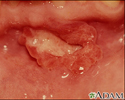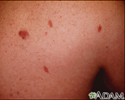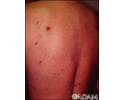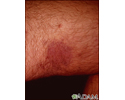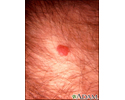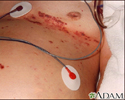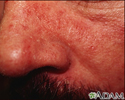HIV/AIDS
HIV infection; Infection - HIV; Human immunodeficiency virus; Acquired immune deficiency syndrome: HIV-1Human immunodeficiency virus (HIV) is the virus that causes acquired immunodeficiency syndrome (AIDS). When a person becomes infected with HIV, the virus attacks and weakens the immune system. As the immune system weakens, the person is at risk for getting life-threatening infections and cancers. When that happens, the illness is called AIDS. Once a person has the virus, it stays inside the body for life.
Causes
The virus is spread (transmitted) person-to-person through certain body fluids:
- Blood
- Semen and preseminal fluid
- Rectal fluids
- Vaginal fluids
- Breast milk
HIV can be spread if these fluids come in contact with:
- Mucous membranes (inside of the mouth, penis, vagina, rectum)
- Damaged tissue (tissue that has been cut or scraped)
- The blood stream by injection
HIV cannot be spread through sweat, saliva, or urine.
In the United States, HIV is mainly spread:
- Through vaginal or anal sex without using a condom with someone who has HIV who is not taking medicines to prevent or treat HIV
- Through needle sharing or other equipment used to inject drugs with someone who has HIV
Less often, HIV is spread:
- From mother to child. A pregnant woman can spread the virus to her unborn baby (fetus) through their shared blood circulation, or a nursing mother can pass it to her baby through her breast milk. Testing and treatment of HIV-positive mothers has helped lower the number of babies getting HIV.
Mother to child
Human immunodeficiency virus (HIV) is the virus that causes AIDS. When a person becomes infected with HIV, the virus attacks and weakens the immune ...
 ImageRead Article Now Book Mark Article
ImageRead Article Now Book Mark Article - Through needle sticks or other sharp objects that are contaminated with HIV (mainly health care workers).
The virus is NOT spread by:
- Casual contact, such as hugging or closed-mouth kissing
- Mosquitoes or pets
- Participating in sports
- Touching items that were touched by a person infected with the virus
- Eating food handled by a person with HIV
- Intimate contact with an HIV-positive person with a stably undetectable viral load
HIV and blood or organ donation:
- HIV is not spread to a person who donates blood or organs. People who donate organs are never in direct contact with the people who receive them. Likewise, a person who donates blood is never in contact with the person receiving it. In all of these procedures, sterile needles and instruments are used.
- Blood banks and organ donor programs thoroughly check (screen) donors, blood, and tissues. It is very unlikely to get HIV from blood transfusions, blood products, or organ or tissue transplants.
Risk factors for getting HIV include:
- Having unprotected anal or vaginal sex. Receptive anal sex is the riskiest. Having multiple partners also increases the risk. Using a new condom correctly every time you have sex greatly helps lower this risk.
- Using drugs and sharing needles or syringes.
- Having a sexual partner with HIV who is not taking HIV medicines or who has a detectable viral load.
- Having a sexually-transmitted disease (STD).
Symptoms
Symptoms related to acute HIV infection (when a person is first infected) can be similar to the flu or other viral illnesses. They include:
- Fever and muscle pains
Fever
Fever is the temporary increase in the body's temperature in response to a disease or illness. A child has a fever when the temperature is at or abov...
 ImageRead Article Now Book Mark Article
ImageRead Article Now Book Mark ArticleMuscle pains
Muscle aches and pains are common and can involve more than one muscle. Muscle pain also can involve ligaments, tendons, and fascia. Fascias are th...
 ImageRead Article Now Book Mark Article
ImageRead Article Now Book Mark Article - Headache
Headache
A headache is pain or discomfort in the head, scalp, or neck. Serious causes of headaches are rare. Most people with headaches can feel much better...
 ImageRead Article Now Book Mark Article
ImageRead Article Now Book Mark Article - Sore throat
Sore throat
Pharyngitis, or sore throat, is discomfort, pain, or scratchiness in the throat. It often makes it painful to swallow.
 ImageRead Article Now Book Mark Article
ImageRead Article Now Book Mark Article - Night sweats
- Mouth sores, including yeast infection (thrush)
Thrush
Thrush is a yeast infection of the tongue and lining of the mouth.
 ImageRead Article Now Book Mark Article
ImageRead Article Now Book Mark Article - Swollen lymph glands
- Diarrhea
Many people have no symptoms when they are first infected with HIV.
Acute HIV infection (Stage 1) progresses over a few weeks to months to become chronic or asymptomatic HIV infection (Stage 2) (no symptoms). This stage can last 10 years or longer. During this period, the person might have no reason to suspect they have HIV, but they can spread the virus to others.
If they are not treated, almost all people infected with HIV will develop AIDS (Stage 3). Some people develop AIDS within a few years of infection. Others remain completely healthy after 10 or even 20 years (called long-term nonprogressors).
People with AIDS have had their immune system damaged by HIV. They are at very high risk of getting infections that are uncommon in people with a healthy immune system. These infections are called opportunistic infections and can affect any part of the body. These can be caused by:
- Bacteria
- Viruses
- Fungi
- Protozoa
People with AIDS are also at higher risk for certain cancers, especially lymphomas and a skin cancer called Kaposi sarcoma.
Kaposi sarcoma
Kaposi sarcoma (KS) is a cancerous tumor of the connective tissue.

Symptoms depend on the particular infection and which part of the body is infected.
Lung infections are common in people with AIDS and often cause cough, fever, and shortness of breath.
Cough
Coughing is an important way to keep your throat and airways clear. But too much coughing may mean you have a disease or disorder. Some coughs are d...

Intestinal infections are also common and can cause:
- Diarrhea
- Abdominal pain
- Vomiting
- Swallowing problems
Other common symptoms in people with HIV infection and AIDS include:
- Weight loss
Weight loss
Unexplained weight loss is a decrease in body weight, when you did not try to lose the weight on your own. Many people gain and lose weight. Uninten...
Read Article Now Book Mark Article - Fever
- Sweats
- Rashes
- Swollen lymph glands
Exams and Tests
There are tests that are done to check if you've been infected with HIV.
DIAGNOSTIC TESTS
In general, testing is a 2-step process:
Testing
In general, testing for the human immunodeficiency virus (HIV) is a 2-step process that involves a screening test and follow-up tests often called co...

- Screening test -- There are several kinds of tests. Some are blood tests, others are mouth fluid tests. They check for antibodies to the HIV virus, HIV antigen, or both. Some screening tests can give results in 30 minutes or less.
Antibodies
An antibody is a protein produced by the body's immune system when it detects harmful substances, called antigens. Examples of antigens include micr...
 ImageRead Article Now Book Mark Article
ImageRead Article Now Book Mark ArticleAntigen
An antigen is any substance that causes your immune system to produce antibodies against it. This means your immune system does not recognize the su...
 ImageRead Article Now Book Mark Article
ImageRead Article Now Book Mark Article - Follow-up test -- This is also called a confirmatory test. It is often done when the screening test is positive.
Home tests are available to test for HIV. If you plan to use one, check to make sure it is approved by the FDA. Follow instructions on the packaging to ensure the results are as accurate as possible.
The Centers for Disease Control and Prevention (CDC) recommends that everyone ages 15 to 65 have a screening test for HIV. People with risky behaviors should be tested regularly. Pregnant women should also have a screening test.
TESTS AFTER BEING DIAGNOSED WITH HIV
People with AIDS should have regular blood tests to check their CD4 cell count:
- CD4 T cells are the blood cells that HIV attacks. They are also called T4 cells or "helper T cells."
- As HIV damages the immune system, the CD4 count drops. A normal CD4 count is from 500 to 1,500 cells/mm3 of blood.
- People usually develop symptoms when their CD4 count drops below 350. More serious complications occur when the CD4 count drops to 200. When the count is below 200, the person is said to have AIDS.
Other tests include:
- HIV RNA level, or viral load, to check how much HIV is in the blood.
- A resistance test to see if the virus has any changes in the genetic code that would lead to resistance to the medicines used to treat HIV.
- Complete blood count, blood chemistry, and urine test.
Complete blood count
A complete blood count (CBC) test measures the following:The number of white blood cells (WBC count)The number of red blood cells (RBC count)The numb...
 ImageRead Article Now Book Mark Article
ImageRead Article Now Book Mark Article - Tests for other sexually transmitted infections.
- TB test.
- Pap test to check for cervical cancer every year ages 21 to 29; after 3 normal tests in a row, test every 3 years. At age 30 and older, HPV test and Pap test every year or just a Pap test; after 3 normal tests in a row, every 3 years. Testing should continue throughout your lifetime.
Pap test
The Pap test mainly checks for changes that may turn into cervical cancer. Cells scraped from the opening of the cervix are examined under a microsc...
 ImageRead Article Now Book Mark Article
ImageRead Article Now Book Mark Article
All adults with HIV should have the following screening test for anal cancer:
- Digital anorectal examination (DARE) and assessment for symptoms of anal cancer (such as pain, burning, or masses) at least once per year
- People under the age of 35 who have symptoms or signs of anal cancer during DARE should undergo standard anoscopy.
Anoscopy
Anoscopy is a method to look at the: AnusAnal canalLower rectum
 ImageRead Article Now Book Mark Article
ImageRead Article Now Book Mark Article
Adults with HIV should have other tests along with high resolution anoscopy (HRA), rather than standard anoscopy, if they are:
High resolution anoscopy
Anoscopy is a method to look at the: AnusAnal canalLower rectum

- Men who have sex with men who are age 35 and older
- Transgender women who are age 35 and older
- All other people with HIV ages 45 and older
If HRA is not available, people with HIV should continue to be screened using an assessment of symptoms and DARE. People with any symptoms or signs of anal cancer should have standard anoscopy, without the collection of anal specimens for diagnosis.
Treatment
HIV/AIDS is treated with medicines that stop the virus from multiplying. This treatment is called antiretroviral therapy (ART).
In the past, people with HIV infection would start antiretroviral treatment after their CD4 count dropped or they developed HIV complications. Today, HIV treatment is recommended for all people with HIV infection, even if their CD4 count is still normal.
There are two types or treatment:
- Pills are given to people who are just starting treatment.
- Shots may be given to people who have an undetectable viral load or who have been virally suppressed for at least 3 months. Shots may be given every month or every other month.
Regular blood tests are needed to make sure the virus level in the blood (viral load) is kept low or suppressed. The goal of treatment is to lower the HIV virus in the blood to a level that is so low that the test can't detect it. This is called an undetectable viral load.
If the CD4 count already dropped before treatment was started, it will usually slowly go up. HIV complications often disappear as the immune system recovers.
Support Groups
Joining a support group where members share common experiences and problems can often help lower the emotional stress of having a long-term illness.
Support group
The following organizations are good resources for information on HIV/AIDS:HIVinfo. NIH. gov -- hivinfo. nih. gov/HIV. gov -- www. hiv. gov/US Dept o...

Outlook (Prognosis)
With treatment, most people with HIV/AIDS can live a healthy and normal life.
Current treatments do not cure the infection. The medicines only work as long as they are taken every day or as prescribed. If the medicines are stopped, the viral load will go up and the CD4 count will drop. If the medicines are not taken regularly, the virus can become resistant to one or more of the medicines, and the treatment will stop working.
People who are on treatment need to see their health care providers regularly. This is to make sure the medicines are working and to check for side effects of the medicines.
When to Contact a Medical Professional
Contact your provider for an appointment if you have any risk factors for HIV infection. Also contact your provider if you develop symptoms of AIDS. By law, the results of HIV testing must be kept confidential (private). Your provider will review your test results with you.
Prevention
Preventing HIV/AIDS:
- Get tested. People who don't know they have HIV infection and who look and feel healthy are the most likely to transmit it to others.
- Do not use illegal drugs and do not share needles or syringes. Many communities have needle exchange programs where you can get rid of used syringes and get new, sterile ones. Staff at these programs can also refer you for substance use disorder treatment.
- Avoid contact with another person's blood. If possible, wear protective clothing, a mask, and goggles when caring for people who are injured.
- If you test positive for HIV, you can pass the virus to others. You should not donate blood, plasma, body organs, or sperm.
- HIV-positive women who might become pregnant should talk to their provider about the risk to their unborn child. They should also discuss methods to prevent their baby from becoming infected, such as taking antiretroviral medicines during pregnancy.
- Breastfeeding should be avoided to prevent passing HIV to infants through breast milk.
Safer sex practices, such as using latex condoms, are effective in preventing the spread of HIV. But there is still a risk of getting the infection, even with the use of condoms (for example, condoms can tear).
Safer sex practices
Safe sex means taking steps before and during sex that can prevent you from getting an infection, or from giving an infection to your partner. These...

In people who aren't infected with the virus, but are at high risk of getting it, certain medicines can help prevent infection.
- Truvada (emtricitabine and tenofovir disoproxil fumarate) - taken as a pill
- Descovy (emtricitabine and tenofovir alafenamide) - taken as a pill
- Apretude (cabotegravir) - given as a shot every other month to help prevent infection
This treatment is known as pre-exposure prophylaxis, or PrEP. Talk to your provider if you think PrEP might be right for you.
HIV-positive people who are taking antiretroviral medicines and have no detectible virus in their blood do not transmit the virus.
The US blood supply is among the safest in the world. Nearly all people infected with HIV through blood transfusions received those transfusions before 1985, the year HIV testing began for all donated blood.
If you believe you have been exposed to HIV, seek medical attention right away. Do not delay. Starting antiviral medicines right after the exposure (up to 3 days after) can reduce the chance that you will be infected. This is called post-exposure prophylaxis (PEP). It has been used to prevent transmission in health care workers injured by needlesticks.
References
Centers for Disease Control and Prevention website. HIV. About HIV. www.cdc.gov/hiv/about/. Updated January 24, 2024. Accessed June 17, 2024.
Centers for Disease Control and Prevention website. HIV. Preventing HIV with PrEP. www.cdc.gov/hiv/prevention/prep.html/. Reviewed January 18, 2024. Accessed June 17, 2024.
DiNenno EA, Prejean J, Irwin K, et al. Recommendations for HIV screening of gay, bisexual, and other men who have sex with men - United States, 2017. MMWR Morb Mortal Wkly Rep. 2017;66(31):830-832. www.cdc.gov/mmwr/volumes/66/wr/mm6631a3.htm.
Reitz MS, Gallo RC. Human immunodeficiency viruses. In: Bennett JE, Dolin R, Blaser MJ, eds. Mandell, Douglas, and Bennett's Principles and Practice of Infectious Diseases. 9th ed. Philadelphia, PA: Elsevier; 2020:chap 169.
Simonetti F, Dewar R, Maldarelli F. Diagnosis of human immunodeficiency virus infection. In: Bennett JE, Dolin R, Blaser MJ, eds. Mandell, Douglas, and Bennett's Principles and Practice of Infectious Diseases. 9th ed. Philadelphia, PA: Elsevier; 2020:chap 120.
Tsibris AMN, Hirsch MS. Antiretroviral therapy for human immunodeficiency virus infection. In: Bennett JE, Dolin R, Blaser MJ, eds. Mandell, Douglas, and Bennett's Principles and Practice of Infectious Diseases. 9th ed. Philadelphia, PA: Elsevier; 2020:chap 128.
US Department of Health and Human Services, Clinical Info.gov website. Guidelines for the use of antiretroviral agents in adults and adolescents with HIV. clinicalinfo.hiv.gov/en/guidelines/hiv-clinical-guidelines-adult-and-adolescent-arv/whats-new?view=full. Updated February 27, 2024. Accessed August 15, 2024.
US Preventive Services Task Force, Owens DK, Davidson KW, Krist AH, et al. Screening for HIV Infection: US Preventive Services Task Force Recommendation Statement. JAMA. 2019;321(23):2326-2336. PMID: 31184701 pubmed.ncbi.nlm.nih.gov/31184701/.
Verma A, Berger JR. Neurological manifestations of human immunodeficiency virus infection in adults. In: Jankovic J, Mazziotta JC, Pomeroy SL, Newman NJ, eds. Bradley and Daroff's Neurology in Clinical Practice. 8th ed. Philadelphia, PA: Elsevier; 2022:chap 77.
STDs and ecological niches - illustration
Many sexually-transmitted diseases (STDs) invade the host and reside for long periods of time without killing the host. A good example is syphilis, which may reside in its host for 30 to 50 years. HIV also can take 10 or more years to kill its host, allowing plenty of time to spread the infection.
STDs and ecological niches
illustration
HIV - illustration
HIV (human immunodeficiency virus) is a viral infection that gradually destroys the immune system. Practicing effective safe sex methods significantly reduces the risk of disease transmission.
HIV
illustration
Primary HIV infection - illustration
HIV (human immunodeficiency virus) is more frequently transmitted through unprotected sex or sharing contaminated needles. Transmission from mother to fetus or through blood products has significantly declined in the United States.
Primary HIV infection
illustration
Canker sore (aphthous ulcer) - illustration
Canker sores (aphthous ulcers) are very common. Typically, they are a shallow ulcer with a white or whitish/yellow base surrounded by a reddish border. This severe form of ulcer can be seen in an individual with AIDS and is located in front and just below the bottom teeth.
Canker sore (aphthous ulcer)
illustration
Mycobacterium marinum infection on the hand - illustration
This bacterial infection is caused by Mycobacterium marinum. Marinum is a relative of the organism which causes tuberculosis. This lesion is often referred to as a swimming pool granuloma. Atypical mycobacterial infections may cause life-threatening disease in people with weakened immune systems (immunocompromised individuals).
Mycobacterium marinum infection on the hand
illustration
Dermatitis - seborrheic on the face - illustration
This is seborrheic dermatitis on the face. Note the redness (erythema) and mild scaling. Individuals with AIDS frequently develop seborrheic dermatitis or other types of skin rashes, as seen in this person who is HIV positive.
Dermatitis - seborrheic on the face
illustration
AIDS - illustration
AIDS (acquired immune deficiency syndrome) is caused by HIV (human immunodeficiency virus), and is a syndrome that leaves the body vulnerable to a host of life-threatening illnesses. There is no cure for AIDS, but treatment with antiviral medicine can suppress symptoms. AIDS is universally fatal, in large part due to the proliferation of opportunistic infections.
AIDS
illustration
Kaposi sarcoma - close-up - illustration
Kaposi sarcoma was once a rare malignancy of the blood vessels but is now associated with AIDS. It is more frequently associated with AIDS in homosexual men than AIDS in IV drug users. The malignancy results most frequently in purplish to reddish-purple flat or grape-like lesions in the skin, gastrointestinal tract, and other organs.
Kaposi sarcoma - close-up
illustration
Histoplasmosis, disseminated in HIV patient - illustration
This is a skin lesion resulting from disseminated histoplasmosis. Histoplasmosis occurs most frequently as a lung infection, however it can infect the skin or become distributed (disseminated) to internal organs.
Histoplasmosis, disseminated in HIV patient
illustration
Molluscum on the chest - illustration
These lesions are associated with the molluscum virus and are present on a person who has a weakened immune system (immunocompromised). Molluscum contagiosum are small, raised, pearly skin lesions caused by the molluscum virus, a member of the poxvirus family. They are seen frequently in children and less often in adults. In adults, they may be considered a sexually transmitted disease. Immunocompromised individuals may experience heavy outbreaks of these lesions, as seen in this photograph.
Molluscum on the chest
illustration
Kaposi sarcoma on the back - illustration
Kaposi sarcoma was once a rare malignancy of the blood vessels but is now associated with AIDS. It is more frequently associated with AIDS in homosexual men than AIDS in IV drug users. Recent research has suggested that this malignancy may be caused by a newly discovered herpes virus. The malignancy results in purplish, grape-like lesions in the skin, gastrointestinal tract, and other organs.
Kaposi sarcoma on the back
illustration
Kaposi sarcoma on the thigh - illustration
Kaposi sarcoma, seen here on the thigh, was once a rare malignancy of the blood vessels, but is now associated with AIDS. It is more frequently associated with AIDS in homosexual men than AIDS in IV drug users. The malignancy results in purplish to reddish-purple grape-like lesions in the skin, gastrointestinal tract, and other organs.
Kaposi sarcoma on the thigh
illustration
Molluscum contagiosum on the face - illustration
Molluscum contagiosum is most commonly seen in children, however it does occur in adults and may cause extensive infection in people with weakened immune systems. In this photograph, multiple small molluscum are seen covering the cheek, upper neck, and in the sideburn.
Molluscum contagiosum on the face
illustration
Antibodies - illustration
Antigens are large molecules (usually proteins) on the surface of cells, viruses, fungi, bacteria, and some non-living substances such as toxins, chemicals, drugs, and foreign particles. The immune system recognizes antigens and produces antibodies that destroy substances containing antigens.
Antibodies
illustration
Tuberculosis in the lung - illustration
Tuberculosis is caused by a group of organisms, Mycobacterium tuberculosis, M bovis, M africanum and a few other rarer subtypes. Tuberculosis usually appears as a lung (pulmonary) infection. However, it may infect other organs in the body. Recently, antibiotic-resistant strains of tuberculosis have appeared. With increasing numbers of immunocompromised individuals with AIDS, and homeless people without medical care, tuberculosis is seen more frequently today. (Image courtesy of the Centers for Disease Control and Prevention.)
Tuberculosis in the lung
illustration
Kaposi sarcoma - lesion on the foot - illustration
Kaposi sarcoma lesion on the foot. This once-rare malignancy of the blood vessels is now associated with AIDS. It is more frequently associated with AIDS in homosexual men than AIDS in IV drug users. The malignancy results in purplish grape-like lesions in the skin, gastrointestinal tract and other organs.
Kaposi sarcoma - lesion on the foot
illustration
Kaposi sarcoma - perianal - illustration
Kaposi sarcoma usually occurs in male homosexuals with AIDS. These lesions can appear anywhere on the body as purple, elevated growths. This sarcoma is located near the anus (perianal).
Kaposi sarcoma - perianal
illustration
Herpes zoster (shingles) disseminated - illustration
Herpes zoster (shingles) normally occurs in a limited area that follows a dermatome (see the dermatome picture). In individuals with damaged immune systems, herpes zoster may be widespread (disseminated), causing serious illness. Herpes zoster is caused by the same virus that causes chickenpox.
Herpes zoster (shingles) disseminated
illustration
Dermatitis seborrheic - close-up - illustration
This is a close-up of seborrheic dermatitis. Note the redness (erythema) and mild scaling. Individuals with AIDS frequently develop seborrheic dermatitis or other types of skin rashes, as seen in this person.
Dermatitis seborrheic - close-up
illustration
STDs and ecological niches - illustration
Many sexually-transmitted diseases (STDs) invade the host and reside for long periods of time without killing the host. A good example is syphilis, which may reside in its host for 30 to 50 years. HIV also can take 10 or more years to kill its host, allowing plenty of time to spread the infection.
STDs and ecological niches
illustration
HIV - illustration
HIV (human immunodeficiency virus) is a viral infection that gradually destroys the immune system. Practicing effective safe sex methods significantly reduces the risk of disease transmission.
HIV
illustration
Primary HIV infection - illustration
HIV (human immunodeficiency virus) is more frequently transmitted through unprotected sex or sharing contaminated needles. Transmission from mother to fetus or through blood products has significantly declined in the United States.
Primary HIV infection
illustration
Canker sore (aphthous ulcer) - illustration
Canker sores (aphthous ulcers) are very common. Typically, they are a shallow ulcer with a white or whitish/yellow base surrounded by a reddish border. This severe form of ulcer can be seen in an individual with AIDS and is located in front and just below the bottom teeth.
Canker sore (aphthous ulcer)
illustration
Mycobacterium marinum infection on the hand - illustration
This bacterial infection is caused by Mycobacterium marinum. Marinum is a relative of the organism which causes tuberculosis. This lesion is often referred to as a swimming pool granuloma. Atypical mycobacterial infections may cause life-threatening disease in people with weakened immune systems (immunocompromised individuals).
Mycobacterium marinum infection on the hand
illustration
Dermatitis - seborrheic on the face - illustration
This is seborrheic dermatitis on the face. Note the redness (erythema) and mild scaling. Individuals with AIDS frequently develop seborrheic dermatitis or other types of skin rashes, as seen in this person who is HIV positive.
Dermatitis - seborrheic on the face
illustration
AIDS - illustration
AIDS (acquired immune deficiency syndrome) is caused by HIV (human immunodeficiency virus), and is a syndrome that leaves the body vulnerable to a host of life-threatening illnesses. There is no cure for AIDS, but treatment with antiviral medicine can suppress symptoms. AIDS is universally fatal, in large part due to the proliferation of opportunistic infections.
AIDS
illustration
Kaposi sarcoma - close-up - illustration
Kaposi sarcoma was once a rare malignancy of the blood vessels but is now associated with AIDS. It is more frequently associated with AIDS in homosexual men than AIDS in IV drug users. The malignancy results most frequently in purplish to reddish-purple flat or grape-like lesions in the skin, gastrointestinal tract, and other organs.
Kaposi sarcoma - close-up
illustration
Histoplasmosis, disseminated in HIV patient - illustration
This is a skin lesion resulting from disseminated histoplasmosis. Histoplasmosis occurs most frequently as a lung infection, however it can infect the skin or become distributed (disseminated) to internal organs.
Histoplasmosis, disseminated in HIV patient
illustration
Molluscum on the chest - illustration
These lesions are associated with the molluscum virus and are present on a person who has a weakened immune system (immunocompromised). Molluscum contagiosum are small, raised, pearly skin lesions caused by the molluscum virus, a member of the poxvirus family. They are seen frequently in children and less often in adults. In adults, they may be considered a sexually transmitted disease. Immunocompromised individuals may experience heavy outbreaks of these lesions, as seen in this photograph.
Molluscum on the chest
illustration
Kaposi sarcoma on the back - illustration
Kaposi sarcoma was once a rare malignancy of the blood vessels but is now associated with AIDS. It is more frequently associated with AIDS in homosexual men than AIDS in IV drug users. Recent research has suggested that this malignancy may be caused by a newly discovered herpes virus. The malignancy results in purplish, grape-like lesions in the skin, gastrointestinal tract, and other organs.
Kaposi sarcoma on the back
illustration
Kaposi sarcoma on the thigh - illustration
Kaposi sarcoma, seen here on the thigh, was once a rare malignancy of the blood vessels, but is now associated with AIDS. It is more frequently associated with AIDS in homosexual men than AIDS in IV drug users. The malignancy results in purplish to reddish-purple grape-like lesions in the skin, gastrointestinal tract, and other organs.
Kaposi sarcoma on the thigh
illustration
Molluscum contagiosum on the face - illustration
Molluscum contagiosum is most commonly seen in children, however it does occur in adults and may cause extensive infection in people with weakened immune systems. In this photograph, multiple small molluscum are seen covering the cheek, upper neck, and in the sideburn.
Molluscum contagiosum on the face
illustration
Antibodies - illustration
Antigens are large molecules (usually proteins) on the surface of cells, viruses, fungi, bacteria, and some non-living substances such as toxins, chemicals, drugs, and foreign particles. The immune system recognizes antigens and produces antibodies that destroy substances containing antigens.
Antibodies
illustration
Tuberculosis in the lung - illustration
Tuberculosis is caused by a group of organisms, Mycobacterium tuberculosis, M bovis, M africanum and a few other rarer subtypes. Tuberculosis usually appears as a lung (pulmonary) infection. However, it may infect other organs in the body. Recently, antibiotic-resistant strains of tuberculosis have appeared. With increasing numbers of immunocompromised individuals with AIDS, and homeless people without medical care, tuberculosis is seen more frequently today. (Image courtesy of the Centers for Disease Control and Prevention.)
Tuberculosis in the lung
illustration
Kaposi sarcoma - lesion on the foot - illustration
Kaposi sarcoma lesion on the foot. This once-rare malignancy of the blood vessels is now associated with AIDS. It is more frequently associated with AIDS in homosexual men than AIDS in IV drug users. The malignancy results in purplish grape-like lesions in the skin, gastrointestinal tract and other organs.
Kaposi sarcoma - lesion on the foot
illustration
Kaposi sarcoma - perianal - illustration
Kaposi sarcoma usually occurs in male homosexuals with AIDS. These lesions can appear anywhere on the body as purple, elevated growths. This sarcoma is located near the anus (perianal).
Kaposi sarcoma - perianal
illustration
Herpes zoster (shingles) disseminated - illustration
Herpes zoster (shingles) normally occurs in a limited area that follows a dermatome (see the dermatome picture). In individuals with damaged immune systems, herpes zoster may be widespread (disseminated), causing serious illness. Herpes zoster is caused by the same virus that causes chickenpox.
Herpes zoster (shingles) disseminated
illustration
Dermatitis seborrheic - close-up - illustration
This is a close-up of seborrheic dermatitis. Note the redness (erythema) and mild scaling. Individuals with AIDS frequently develop seborrheic dermatitis or other types of skin rashes, as seen in this person.
Dermatitis seborrheic - close-up
illustration
Review Date: 5/19/2023
Reviewed By: Jatin M. Vyas, MD, PhD, Associate Professor in Medicine, Harvard Medical School; Associate in Medicine, Division of Infectious Disease, Department of Medicine, Massachusetts General Hospital, Boston, MA. Also reviewed by David C. Dugdale, MD, Medical Director, Brenda Conaway, Editorial Director, and the A.D.A.M. Editorial team. Editorial update 08/15/2024.








